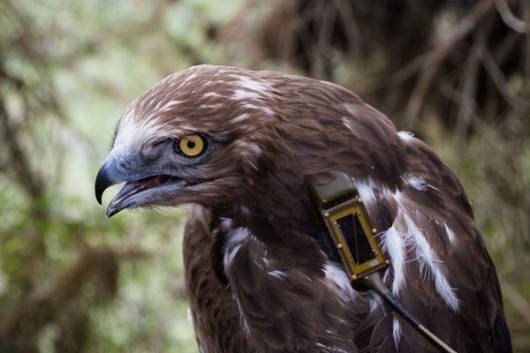LINKED PAPER
Individual variation in orientation promotes a 3000-km latitudinal change in wintering grounds in a long-distance migratory raptor. 2016. Mellone U., Lucia G., Mallìa E., Urios V., 2016. IBIS. DOI: 10.1111/ibi.12401 VIEW
LONG TERM FIELD OBSERVATIONS
The special geography of the Italian peninsula makes it an ideal benchmark to study orientation strategies of raptors and their response to large sea crossings (Agostini 2004). The migration route followed by Italian Short-toed Eagles, Circaetus gallicus, has been investigated in the last 20 years by several ornithologists, first by visual observations and then by satellite telemetry. Historically, the species has been always quite rare in the Strait of Messina, the main migration bottle-neck of the Central Mediterranean. Contrasting this with the fact that hundreds of breeding pairs were known to breed in the Italian peninsula, Agostini & Malara (1997) have been the first to hypothesize that eagles were not entering from Sicily, but instead from France.
In the early 2000’s, the cooperative effort of some ornithologists carrying out simultaneous observations in different locations, from Malta to North-Western Italy, demonstrated that indeed the great majority of short-toed eagles abandon Italy in mid-September going towards the North and then turning to the West en route to France (Agostini et al. 2002). The keystone to corroborate this theory have been the observations carried out in Capriglia (Tuscany), where every migration season ca. 2000 eagles are observed (Premuda et al. 2015). They migrate in a direction opposite to the one followed by any other migrating bird in the Northern hemisphere: going north in autumn and going south in spring.

Why do these eagles follow such a detoured route? The answer lies in their morphology: broad wings suited for soaring flight using thermal currents, that being absent over water, make sea-crossings very expensive from the energy point of view. Following the detoured route, eagles can avoid the costly and risky crossing of the Sicily channel (150 km over the sea), switching to the safer Strait of Gibraltar (14 km), even if the overland flight becomes much longer (Mellone et al. 2011a). Furthermore, the observation of many juveniles in mixed groups with adults during autumn suggests that these inexperienced individuals can learn the route from experienced ones.
However, it remained unknown for a longer time (and still it is, in part) why some tens, if not hundreds, of short-toed eagles are observed in Sicily and the surrounding islands (including Malta) during autumn migration and also why the species winters regularly in the former island. Especially in the island of Marettimo, flocks of ten of individuals, especially juveniles, are observed in October, a late period for the migration of the species (Agostini et al 2009).

SATELLITE TRACKING
In order to get a more complete picture on the migration strategies of short-toed eagles, in the 2010 the University of Alicante (Spain) began a satellite tracking study within the Gallipoli Cognato Piccole Dolomiti Lucane Regional Park, in Southern Italy. Given that, according to previous experience with the species, capturing adults was very difficult if not impossible, we focused on nest search in order to tag juveniles before fledging. Thanks also to the help of local ornithologists we identified four territories, in which we tagged with GPS seven juveniles, between the 2010 and the 2013. The majority of these juveniles (5) used the detoured route and reached the sub-Saharan wintering grounds after the crossing of the Strait of Gibraltar, probably migrating with adults at least during the first leg of migration. Instead, two individuals migrated towards the South following inherited information, trying also to cross to Africa through the island of Marettimo, and finally remaining in Sicily for the whole winter, 3,000 km to the North in comparison with their conspecifics. During spring and summer of the following year both eagles started to wander between Sicily and Southern Italy. One was poached close to the Strait of Messina, while the other one survived enough to show that the learning process of the detoured route can take place also in the second year, being unfortunately poached in Southern Spain (Mellone et al. 2016).

© Ugo Mellone
TOWARDS A COMPLETE PICTURE
These results obtained through satellite tracking confirm visual observations, suggesting that a minority (ca. the 20%) of juvenile short-toed eagles from the population of the Italian peninsula do not learn the detoured route during the first year. What still remains unknown is the reason of such bimodal orientation pattern within the same population. Unfortunately our data cannot confirm if, for example, south migrating individuals are mainly late fledging ones, or belonging to peripheral territories, attributes that theoretically can make more difficult to find an adult to follow (Oppel et al. 2015). Interestingly, a similar strategy is followed also by Greek short-toed eagles breeding in Peloponnesus, which cross the Bosphorus, instead of reaching Africa directly through a long sea crossing (Panuccio et al. 2012).
We are not tagging short-toed eagle anymore, but currently an individual born in the 2013 is still transmitting and we hope it will breed for the first time before the GPS stops to work. It is possible to follow its travels on this website. This individual has been also the first one tagged by our research group that, instead of spending the summer in North Africa (like the majority of immatures short-toed eagles, see Mellone et al. 2011b), is coming back every spring close to its natal area in Italy.

© Ugo Mellone
REFERENCES
Agostini N. 2004. Additional observations of age-dependent migration behaviour in western honey buzzards Pernis apivorus. Journal of Avian Biology 35: 469-470. VIEW
Agostini N., Baghino L., Coleiro C., Corbi F. & Premuda G. 2002. Circuitous autumn migration in the Short-toed Eagle (Circaetus gallicus). Journal of Raptor Research 36: 111-114. VIEW
Agostini N. & Malara G. 1997. Entità delle popolazioni di alcune specie di rapaci Accipitriformi migranti, in primavera, sul Mediterraneo centrale. Rivista italiana di Ornitologia 66: 174-176.
Agostini, N., Panuccio, M., Lucia, G., Liuzzi, C., Amato, P., Provenza, A., Gustin, M. & Mellone, U. 2009. Evidence for age-dependent migration strategies in the short-toed eagle. British Birds 102: 506-508. VIEW
Mellone, U., Limiñana, R., Mallìa, E. & Urios, V. 2011a. Extremely detoured migration in an inexperienced bird: interplay of transport costs and social interactions. Journal of Avian Biology 42:468–472. VIEW
Mellone, U., Yáñez, B., Limiñana, R., Muñoz, A.R., Pavón, D., González, J.M., Urios, V. & Ferrer, M. 2011b. Summer staging areas of non-breeding Short-toed Snake Eagles. Bird Study 58: 516–521. VIEW
Oppel, S., Dobrev, V., Arkumarev, V., Saravia, V., Bounas, A., Kret, E., Velevski, M., Stoychev, S. & Nikolov, S.C. 2015. High juvenile mortality during migration in a declining population of a long-distance migratory raptor. IBIS 157: 545-557. VIEW
Panuccio, M., Agostini, N. & Premuda, G. 2012. Ecological barriers promote risk minimization and social learning in migrating short-toed snake eagles. Ethology Ecology and Evolution 24: 74-80. VIEW
Premuda, G., Belosi, A., Viviani, F. & Franchini, M. 2015. Short-toed Eagle Circaetus gallicus population monitoring at the Apuane Alps migration watch-site (Tuscany). Avocetta 39: 5-12 VIEW
Image credit
Featured image: Juvenile Short-toed Eagle in the nest © Ugo Mellone



